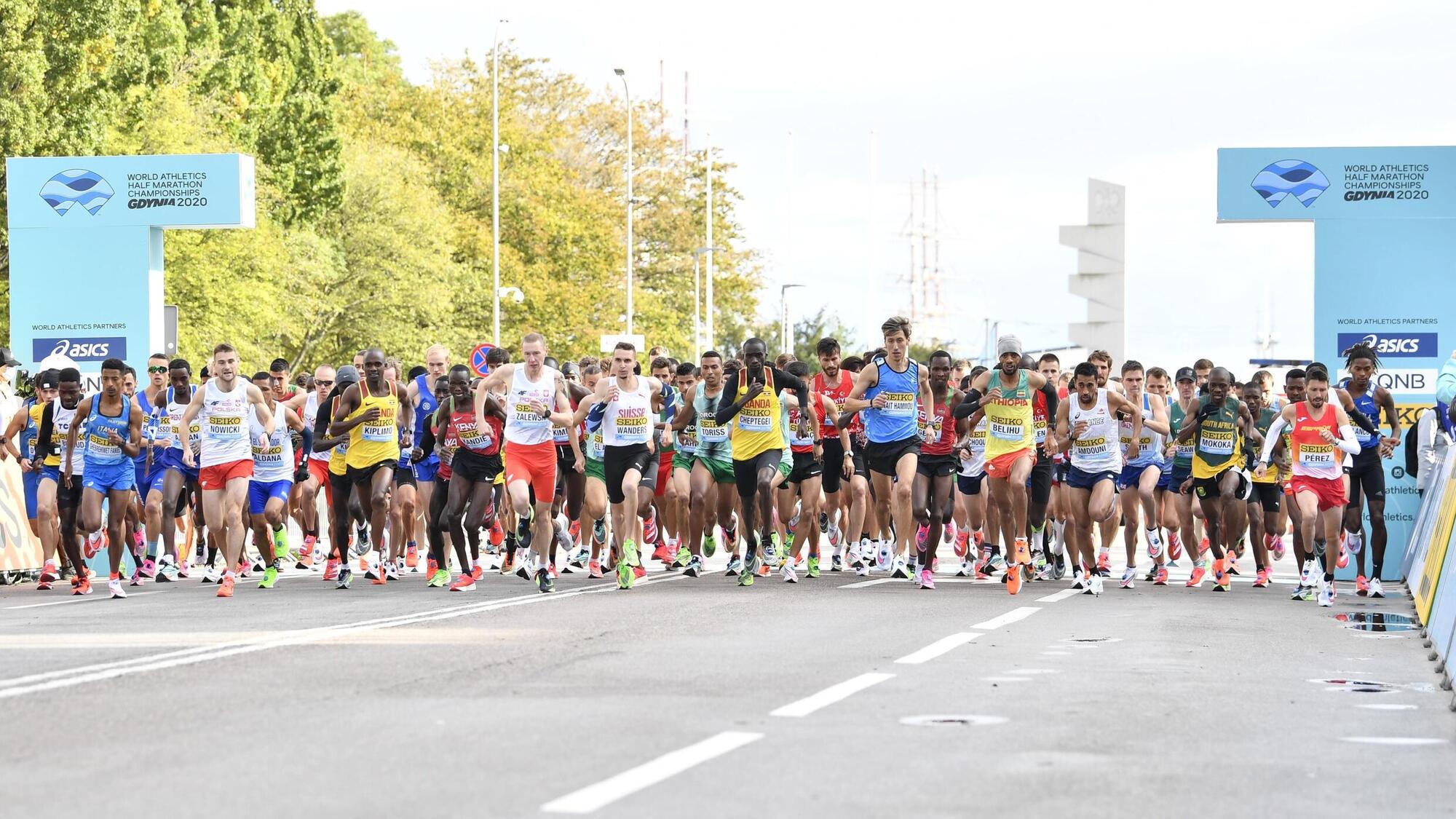Home>Misc>Featured>How Long Do You Have To Train For A Marathon


Featured
How Long Do You Have To Train For A Marathon
Modified: August 21, 2023
Discover how long you need to train for a marathon and unlock the secrets to successful marathon training in this featured guide.
Introduction
Training for a marathon is a significant endeavor that requires dedication, discipline, and careful planning. Whether you are an experienced runner looking to tackle your first marathon or a novice taking on the challenge, it is essential to understand the time commitment involved in preparing for this demanding distance.
Running a marathon is not simply a matter of lacing up your shoes and hitting the pavement. It requires months of consistent training to build the necessary endurance, strength, and mental fortitude to complete the 26.2-mile journey. Before embarking on your training journey, there are several factors to consider to ensure that you set realistic goals and approach your marathon training in a safe and effective manner.
In this article, we will explore the various aspects of marathon training and provide you with valuable insights and tips on how to train effectively for this challenging event. From creating a training plan to incorporating speed workouts, engaging in strength training, and focusing on proper nutrition and recovery, we will cover all the essential components needed to prepare for a marathon.
It is important to note that there is no one-size-fits-all approach to marathon training. Every individual is different, and the training plan that works for one person may not work for another. Additionally, your training needs and abilities may vary depending on factors such as your fitness level, running experience, and personal goals.
So, whether you are aiming to achieve a specific time goal, simply want to complete the marathon, or are looking to challenge yourself both physically and mentally, this article will provide you with the necessary guidance and insights to help you on your marathon training journey. Remember, training for a marathon is a personal achievement that requires commitment, patience, and perseverance. So let’s dive in and explore the world of marathon training!
Factors to Consider Before Training
Before diving into your marathon training, there are several important factors that you should consider. These factors will help you set realistic goals and ensure a safe and enjoyable training experience.
1. Current Fitness Level: Take an honest assessment of your current fitness level. If you are new to running or have been inactive for a while, it is important to gradually build up your fitness before starting a marathon training program. Consider working on your running endurance and cardiovascular fitness through shorter runs and other forms of aerobic exercise.
2. Running Experience: Your previous running experience will influence how you approach your marathon training. If you have been running consistently and have completed races in the past, you may be able to handle a more intense training program. However, if you are a beginner, it is advisable to start with a beginner-friendly training plan that emphasizes gradual progression and includes ample rest days.
3. Time commitment: Training for a marathon requires a significant time commitment. Consider your work, family, and other commitments to determine how many hours per week you can dedicate to training. It is important to be realistic and ensure that you have enough time to properly recover between workouts.
4. Injury history: If you have a history of running-related injuries, it is crucial to address these issues before starting your marathon training. Consult with a medical professional or a running coach to identify any underlying issues and develop a plan to prevent future injuries.
5. Personal goals: Set clear and realistic goals for your marathon. Determine whether you are aiming for a specific finishing time, simply want to complete the marathon, or have other personal goals in mind. Having clear goals will help you tailor your training to meet your expectations.
6. Support system: Consider the support system you have in place during your marathon training. This can include training partners, running groups, or even a coach. Having a support system can provide motivation, accountability, and guidance throughout your training journey.
By considering these factors before beginning your marathon training, you can better prepare yourself mentally and physically for the challenges that lie ahead. Understanding your current abilities and limitations will allow you to create a training plan that suits your individual needs and increases your chances of success on race day.
Creating a Training Plan
A well-structured training plan is essential for marathon preparation. It provides a roadmap for your training, ensuring that you gradually increase your mileage, build endurance, and incorporate necessary recovery periods. Here are some key steps to consider when creating your marathon training plan:
1. Determine the Length of Your Training Cycle: Most marathon training plans range from 12 to 20 weeks. The length of your training cycle will depend on your current fitness level, running experience, and goals. Beginners may opt for a longer training period to allow for a more gradual progression.
2. Set Weekly Mileage Targets: Determine how many miles or kilometers you aim to run per week during your training. Be sure to balance intensity with rest days to avoid overtraining and reduce the risk of injury.
3. Gradually Increase Mileage: As a general rule, aim to increase your weekly mileage by no more than 10% each week. This gradual progression allows your body to adapt to the demands of marathon training and reduces the risk of overuse injuries.
4. Incorporate Different Types of Runs: Your training plan should include a variety of running workouts to target different aspects of your fitness. This can include long slow runs to build endurance, tempo runs to improve lactate threshold, and interval or speed workouts to enhance speed and strength.
5. Schedule Rest and Recovery: Rest and recovery days are just as important as the training days themselves. Allow for at least one or two rest days each week to give your body time to repair and rebuild. Incorporate lighter training days or cross-training activities, such as cycling or swimming, to reduce the impact on your joints while maintaining cardiovascular fitness.
6. Listen to Your Body: Pay attention to how your body responds to the training. If you feel excessively fatigued or experience persistent pain or discomfort, it may be a sign that you need extra rest or should seek advice from a healthcare professional.
7. Flexibility in the Plan: Understand that life can throw unexpected challenges your way. Be open to adjusting your training plan as needed, whether it’s due to unforeseen circumstances, illness, or injury. Adaptability is key to long-term success.
8. Gradual Tapering: In the final weeks leading up to the marathon, gradually reduce your training volume to allow your body to recover and replenish energy stores. This tapering period helps ensure that you are fresh and well-rested on race day.
By creating a well-thought-out training plan and following it consistently, you set yourself up for success in your marathon journey. Remember, every runner is different, so feel free to modify or seek expert guidance to tailor your training plan to suit your specific needs and goals.
Building Endurance
Building endurance is a critical aspect of marathon training. The ability to sustain a consistent pace over a long distance requires both physical and mental stamina. Here are some effective strategies to help you build endurance:
1. Long Slow Runs: Incorporate weekly long slow runs into your training schedule. These runs are typically done at a comfortable, conversational pace and gradually increase in distance over time. Long runs simulate the demands of the marathon and help build endurance.
2. Increase Mileage Gradually: Aim to gradually increase your mileage each week. As your body adapts to the increased workload, you will develop greater endurance. Remember, the 10% rule of increasing mileage applies here to avoid overuse injuries.
3. Time on Your Feet: While total mileage is important, it is equally essential to spend time on your feet during training. This means gradually increasing the duration of your runs, not just the distance. Longer duration runs help train your body to handle the physical demands of running for an extended period.
4. Incorporate Progression Runs: Progression runs involve starting at a comfortable pace and gradually increasing your speed throughout the run. They help to improve your ability to sustain a faster pace over longer distances, building both physical and mental endurance.
5. Hill Training: Running hills is an excellent way to build both endurance and strength. Incorporate hill repeats or find hilly routes for your training runs. The uphill segments challenge your cardiovascular system and increase muscular strength, which in turn improves endurance.
6. Cross-Training: Engaging in cross-training activities such as cycling, swimming, or elliptical training can help supplement your running and reduce the risk of overuse injuries. These activities provide cardiovascular benefits while giving your running muscles a break.
7. Consistency: Consistency is key when it comes to building endurance. Regularly sticking to your training schedule and gradually increasing the workload will ensure that your body adapts and becomes more efficient as your training progresses.
Remember, building endurance takes time and patience. It is important to listen to your body and not push too hard too soon. Gradual and progressive training will yield the best results and help you develop the endurance needed for marathon success.
Incorporating Speed Workouts
Speed workouts are an integral part of marathon training as they help improve running economy, increase lactate threshold, and enhance overall race performance. While endurance is crucial for marathon success, incorporating speed workouts into your training plan can take your running to the next level. Here are some effective strategies to incorporate speed workouts:
1. Tempo Runs: Tempo runs are done at a comfortably hard pace, just below your lactate threshold. They improve your body’s ability to clear lactate from the muscles, allowing you to sustain a faster pace for a longer time. Start with shorter tempo runs, such as 2-3 miles, and gradually increase the distance as your fitness improves.
2. Interval Training: Interval training involves running hard efforts at a specific pace followed by a recovery period. For instance, you can run 400-meter repeats at a faster pace than your race pace, followed by a short recovery jog. This type of workout helps improve speed, VO2 max, and overall anaerobic capacity.
3. Fartlek Runs: Fartlek, a Swedish term meaning “speed play,” involves alternating between faster and slower running segments during a run. It is a more flexible and unstructured form of speed training. Incorporate fast bursts of running into your regular training runs, such as sprinting to a landmark or picking up the pace for a designated time period. Fartlek runs help simulate race conditions and improve pacing skills.
4. Hill Repeats: Running hill repeats involves sprinting uphill for a designated distance or time and then recovering by jogging or walking back down. Hill repeats build leg strength, power, and speed. Find a moderately steep hill and perform 6-8 repeats, gradually increasing the number of repeats as your training progresses.
5. Strides: Strides, also known as accelerations, are short bursts of faster running, usually around 80-100 meters. They help improve running form, stride efficiency, and neuromuscular coordination. Add strides as a part of your warm-up or at the end of an easy run, gradually increasing the number of repetitions.
6. Track Workouts: If access to a track is available, track workouts can be an excellent way to incorporate structured speed training. These workouts typically involve running intervals of specific distances, such as 800 meters or 1-mile repeats, at a set pace. Track workouts help improve pacing, speed, and mental toughness.
When incorporating speed workouts into your training plan, it is important to have a balanced approach. Do not overdo it or neglect your endurance and recovery runs. Start with one speed session per week and gradually increase as your body adapts. Additionally, ensure you have appropriate rest periods between speed workouts to aid in recovery and minimize the risk of injuries.
By incorporating speed workouts into your training plan, you can improve your overall running performance and increase your chances of achieving your desired marathon goals.
Strength Training for Marathon Preparation
In addition to running, incorporating strength training into your marathon preparation can be highly beneficial. Strength training helps improve running economy, enhances muscular endurance, reduces the risk of injury, and boosts overall performance. Here are some key considerations for incorporating strength training into your marathon preparation:
1. Focus on Core Strength: Your core muscles provide stability and help maintain proper running form. Incorporate exercises that target the muscles of your abdomen, lower back, and hips. Planks, Russian twists, and bridges are effective exercises that can be done with minimal equipment.
2. Build Lower Body Strength: Strong legs and hips are essential for running a marathon. Squats, lunges, step-ups, and calf raises can help strengthen the muscles in your lower body. Include both bodyweight exercises and, if appropriate, progressively add resistance through weights or resistance bands.
3. Include Upper Body Exercises: While running primarily involves the lower body, having a strong upper body can improve running efficiency and posture. Incorporate exercises such as push-ups, pull-ups, and rows to strengthen your arms, shoulders, and back.
4. Incorporate Plyometric Exercises: Plyometric exercises, also known as jump training, can help improve power and explosiveness. Exercises like box jumps, squat jumps, and burpees enhance muscular coordination and improve running economy.
5. Balance and Stability Exercises: It is essential to work on enhancing your balance and stability, as this can help prevent injuries and improve overall running efficiency. Incorporate exercises like single-leg squats, lateral lunges, and stability ball exercises to challenge your balance and increase joint stability.
6. Cross-Training Activities: Cross-training activities such as cycling, swimming, or using the elliptical machine can help strengthen muscles while reducing the impact on your joints. These activities can be excellent alternatives on recovery days or as supplementary workouts to complement your running.
7. Consistency and Progression: Just like with running, consistency and progressive overload are key in strength training. Start with lighter weights or easier variations of exercises and gradually increase the intensity as your strength improves. Set realistic goals and aim to incorporate strength training 2-3 times a week.
Remember, it is essential to maintain a balance between strength training and running. Avoid overtraining and give your muscles time to recover between sessions. If you are new to strength training, consider working with a qualified trainer to ensure proper form and technique.
By incorporating strength training into your marathon preparation, you can improve your overall running performance, reduce the risk of injuries, and enhance your ability to handle the demands of marathon training and race day.
Rest and Recovery
Rest and recovery are essential components of any marathon training plan. Giving your body time to rest and repair is just as important as the training itself. Proper rest and recovery help prevent injuries, reduce fatigue, and optimize performance. Here are some key considerations for incorporating rest and recovery into your marathon preparation:
1. Rest Days: Schedule regular rest days throughout your training plan. These are days when you completely abstain from running or any intense physical activity. Rest days give your muscles time to repair and rebuild, allowing for adaptation and growth.
2. Listen to Your Body: Pay attention to how your body feels during training. If you experience excessive fatigue, persistent muscle soreness, or other signs of overtraining, it may be a sign that you need extra rest. Allow yourself to take additional days off or modify your training as needed.
3. Sleep: Quality sleep is crucial for recovery and overall well-being. Aim for 7-9 hours of uninterrupted sleep each night. Establish a relaxing nighttime routine and create a sleep-friendly environment to optimize your rest and recovery.
4. Active Recovery: On days off from running, engage in low-impact activities such as walking, swimming, or gentle cycling to promote blood flow and aid in recovery. Active recovery helps reduce muscle stiffness and promotes faster healing.
5. Foam Rolling and Stretching: Incorporate foam rolling and stretching into your routine to alleviate muscle tightness and improve flexibility. Target areas prone to tightness, such as the calves, quadriceps, and IT band. This can help prevent injuries and improve recovery.
6. Massage and Physical Therapy: Consider incorporating regular massages or seeing a physical therapist to address any muscle imbalances or areas of tightness. These treatments can aid in muscle recovery and enhance overall mobility and flexibility.
7. Nutrition and Hydration: Proper nutrition and hydration play a vital role in rest and recovery. Ensure you are fueling your body with nutritious foods and staying hydrated throughout your training. Adequate protein intake is particularly important for muscle repair and growth.
8. Tapering: In the weeks leading up to the marathon, incorporate a tapering phase into your training plan. Gradually reduce your training volume to allow your body to fully recover and be fresh for race day.
Remember that rest and recovery are not signs of weakness but rather crucial components of a successful marathon training plan. By prioritizing adequate rest, you enable your body to adapt, become stronger, and perform at its best on race day.
Nutrition and Hydration
Nutrition and hydration play a vital role in marathon training and performance. Proper fueling before, during, and after training runs is essential for optimizing energy levels, enhancing recovery, and supporting overall health. Here are some key considerations for nutrition and hydration during marathon training:
1. Balanced Diet: Focus on consuming a balanced diet that includes a variety of fruits, vegetables, whole grains, lean proteins, and healthy fats. This ensures you get the necessary vitamins, minerals, and macronutrients to support your training and recovery.
2. Adequate Calories: Training for a marathon requires a higher calorie intake to fuel your workouts and support your body’s energy needs. Ensure you consume enough calories to maintain your weight and meet your training demands.
3. Carbohydrates: Carbohydrates are the primary source of fuel for endurance activities like running. Include complex carbohydrates like whole grains, fruits, and vegetables in your diet to provide sustained energy for your training runs and recovery.
4. Protein: Protein is crucial for muscle repair and growth. Include lean protein sources such as chicken, fish, tofu, eggs, or legumes in your meals and snacks. Aim for approximately 1.2-1.7 grams of protein per kilogram of body weight per day.
5. Hydration: Stay hydrated before, during, and after your runs. Aim to drink water regularly throughout the day and consider electrolyte-rich sports drinks during longer or intense workouts. Monitor your urine color to ensure hydration levels are adequate.
6. Pre-Run Nutrition: Consume a balanced meal or snack containing carbohydrates and a moderate amount of protein before your training runs. This provides fuel for your workout and helps prevent low blood sugar levels.
7. During-Run Nutrition: For longer runs, consider fueling with easily digestible carbohydrates such as energy gels, sports drinks, or energy bars. Experiment with different options during your training to find what works best for you.
8. Post-Run Recovery: Refuel within 30-60 minutes after your run with a combination of carbohydrates and protein to promote muscle recovery. This can be in the form of a balanced meal or a protein shake.
It is important to note that everyone’s nutritional needs may vary. Experiment with different foods and hydration strategies during your training to find what works best for your body. Consulting with a registered dietitian specializing in sports nutrition can provide personalized guidance and help optimize your nutrition plan.
Incorporating proper nutrition and hydration practices into your marathon training can significantly impact your performance, recovery, and overall well-being. By fueling your body with the necessary nutrients and staying hydrated, you set yourself up for success on race day.
Mental Preparation for Marathon Training
Running a marathon is not just a physical challenge; it is also a mental one. Mental preparation plays a crucial role in your ability to stay motivated, maintain focus, and overcome obstacles during training and on race day. Here are some key strategies for mental preparation during marathon training:
1. Set Clear Goals: Establish clear and realistic goals for your marathon. Whether it’s finishing within a specific time or simply completing the race, having a concrete goal provides motivation and helps you measure progress throughout your training.
2. Positive Self-Talk: Cultivate a positive mindset by using positive self-talk. Replace negative thoughts with encouraging and uplifting statements. Remind yourself of your capabilities, inner strength, and previous accomplishments as a source of motivation.
3. Visualization: Visualize yourself successfully completing the marathon. Imagine the feeling of crossing the finish line, the sights, and the crowd’s support. Visualizing a positive outcome can help reduce anxiety and increase confidence.
4. Practice Mindfulness: Incorporate mindfulness or meditation into your daily routine. These practices help train your mind to stay present, calm, and focused, which can be beneficial during long training runs and on race day.
5. Develop a Mantra: Create a personal mantra or phrase that resonates with you. Repeat it to yourself during challenging moments in training or during the race to stay motivated and focused. It can be as simple as “I am strong” or “I can do this.”
6. Break the Race into Smaller Milestones: Rather than focusing on the entire distance, break the race into smaller, manageable segments or milestones. This approach allows you to direct your attention and energy toward reaching each milestone, making the overall distance feel more achievable.
7. Practice Mental Toughness: Training your mental toughness is just as important as training your physical endurance. Integrate challenging runs and workouts into your training plan to push yourself out of your comfort zone and develop mental resilience.
8. Seek Support and Encouragement: Surround yourself with a supportive network of family, friends, or fellow runners who understand your journey and can provide encouragement and motivation when needed. Share your goals and progress to stay accountable.
Remember, marathon training is a journey that requires dedication, perseverance, and mental fortitude. By implementing mental preparation techniques, you can cultivate a positive mindset, stay focused, and conquer any challenges that come your way.
Dealing with Injuries and Setbacks
Dealing with injuries and setbacks is an unfortunate but common part of marathon training. Injuries can disrupt your training plan and leave you feeling discouraged. However, how you handle these setbacks can significantly impact your marathon journey. Here are some strategies for dealing with injuries and setbacks:
1. Listen to your Body: Pay attention to any signs of pain, discomfort, or unusual sensations during your training runs. Ignoring these signals can lead to further injury. Rest or seek medical attention when necessary and allow your body time to heal.
2. Seek Professional Help: If an injury persists or worsens, consult with a healthcare professional or a sports medicine specialist who can provide an accurate diagnosis and develop a treatment plan. Physical therapy or rehabilitation programs may be necessary to aid your recovery.
3. Acceptance and Adaptation: Accept that setbacks are a normal part of the marathon training process. Embrace the situation and adjust your training plan accordingly. This might involve modifying your workouts, reducing mileage, or cross-training to maintain fitness while allowing your injury to heal.
4. Focus on Rehabilitation: Follow a structured rehabilitation program provided by your healthcare professional or physical therapist. This may include specific exercises, stretches, and strengthening routines tailored to your injury. Consistency and adherence to the program are key to a successful recovery.
5. Stay Positive and Patient: Maintain a positive mindset and trust the process of recovery. Understand that setbacks are temporary and do not define your overall progress. Patience is essential during this time, as rushing back into training too soon can lead to further setbacks.
6. Use Cross-Training: If you are unable to run due to an injury, consider incorporating low-impact cross-training activities such as swimming, cycling, or using an elliptical machine. These activities allow you to maintain aerobic fitness while minimizing impact on the injured area.
7. Set New Goals: Adjust your goals and expectations based on your injury and recovery progress. Be flexible and focus on smaller milestones or alternative races if necessary. Celebrate achievements along the way, even if they are not what you initially planned.
8. Learn from the Experience: Use setbacks as an opportunity to learn more about your body, potential weak points, and how to prevent similar injuries in the future. Reflect on possible causes of the setback, such as overtraining, improper form, or inadequate rest, and make the necessary adjustments moving forward.
Remember, setbacks are a normal part of the marathon journey. Instead of letting them discourage you, approach them as opportunities for growth, learning, and coming back stronger. With patience, proper rehabilitation, and a positive mindset, you can overcome setbacks and continue on your path to marathon success.
The Final Weeks of Training
The final weeks leading up to the marathon are crucial for fine-tuning your fitness, building confidence, and preparing yourself mentally and physically for race day. During this time, it is important to focus on key aspects of your training to ensure you are well-prepared. Here are some guidelines for the final weeks of marathon training:
1. Tapering: Gradually reduce your training volume in the last two to three weeks before the marathon. This allows your body to recover and replenish energy stores while maintaining fitness. Tapering also helps reduce fatigue and risk of injury, ensuring you are fresh on race day.
2. Maintain Intensity: While reducing overall mileage, maintain the intensity of your runs during the taper period. Include shorter, faster-paced workouts to keep your legs sharp and maintain your running efficiency.
3. Simulate Race Day Conditions: During long runs in the final weeks of training, practice your pre-race routine, including nutrition and hydration strategies. Wear the same gear you plan to wear on race day to ensure comfort and avoid any surprises on race day.
4. Mental Rehearsal: Visualize yourself running the marathon successfully. Imagine the challenges you may face during the race and mentally prepare strategies to overcome them. Visualize crossing the finish line with a sense of accomplishment and joy.
5. Focus on Recovery: Prioritize recovery during the final weeks. This includes getting adequate sleep, eating nutritious meals, and managing stress levels. Allow your body to fully recover from training sessions and avoid any strenuous activities that may increase the risk of injury.
6. Race Strategy: Develop a race strategy based on your training progress and goals. This includes pacing, fueling, and hydration plans. Break the race down into smaller segments and have a plan for each section to help maintain focus and motivation throughout.
7. Practice Race Pace: During your final long runs, incorporate miles at your goal race pace. This will help you get accustomed to the pace and build confidence in your ability to maintain it over the entire marathon distance.
8. Stay Positive: Maintain a positive mindset during the final weeks of training. Trust in the work you have put in and believe in your abilities. Surround yourself with supportive people who can provide encouragement and motivation during this critical phase.
Remember, the final weeks of training are about fine-tuning your physical fitness and preparing mentally for the marathon. Be confident in your training and trust in your body’s ability to perform on race day. With proper tapering, attention to recovery, and a positive mindset, you will be ready to conquer the marathon and achieve your goals.
Race Day Strategies and Tips
Race day is the culmination of your marathon training journey and the time to put all your hard work into action. Having a solid race day strategy and implementing effective tips can make a significant difference in your marathon experience. Here are some strategies and tips for a successful race day:
1. Stick to Your Plan: Follow the race strategy you developed during your training. Stick to your pacing plan and avoid starting too fast. Trust in the training you have done and stay focused on your goals.
2. Start Slow and Pacing: Begin the race conservatively, even if you feel fresh and energetic. Starting too fast can lead to burnout later in the race. Gradually settle into your target pace, and adjust as needed during the course of the marathon.
3. Hydration and Nutrition: Stick to your planned hydration and nutrition strategies. Take advantage of aid stations to stay hydrated and fuel with energy gels or other snacks you may have practiced with during your training runs. Avoid trying new products or foods on race day.
4. Break the Race Down: Mentally break the race down into smaller segments or landmarks. Focus on one mile or kilometer at a time, allowing you to stay present and maintain motivation. Celebrate reaching each milestone, and use them as stepping stones toward the finish line.
5. Mental Mantras and Visualization: Use the mental strategies you practiced during training to stay focused and motivated. Repeat positive mantras or visualize yourself crossing the finish line strong and with a sense of accomplishment.
6. Stay Flexible: Be prepared to adapt your race strategy if unforeseen circumstances occur, such as extreme weather conditions. Remember that your primary goal is to finish the race, so adjust your pace and expectations accordingly.
7. Stay Positive and Enjoy the Experience: Embrace the atmosphere of the race and draw energy from the crowds and fellow runners. Smile, thank volunteers, and enjoy the journey. A positive mindset can help carry you through the tough moments.
8. Use Your Training as Confidence: Trust in the training you have done and the miles you have logged. Remind yourself of the challenging workouts and long runs you have conquered. This will boost your confidence during the race and help you push through any moments of doubt.
Remember, race day is the culmination of your hard work and dedication. Enjoy the experience and be proud of yourself for taking on the challenge. Stay calm, trust in your preparation, and give it your all. You are ready to achieve your marathon goals!
Conclusion
Training for a marathon is a challenging and rewarding journey that requires commitment, discipline, and careful planning. By considering factors such as your fitness level, running experience, and personal goals, you can create a well-rounded training plan to suit your individual needs. Building endurance, incorporating speed workouts, and engaging in strength training all play essential roles in preparing your body for the demands of a marathon.
Rest and recovery, nutrition and hydration, and mental preparation are equally important components to consider throughout your training. Properly fueling your body, allowing for adequate rest, and developing a positive mindset will greatly enhance your overall performance and enjoyment of the marathon experience.
Dealing with injuries and setbacks is a normal part of marathon training. It is crucial to listen to your body, seek professional help when necessary, and maintain a positive mindset as you navigate these challenges. The final weeks leading up to the marathon are an opportunity to fine-tune your fitness, focus on recovery, and prepare yourself mentally for race day.
On race day, implementing a solid strategy, pacing yourself, and staying positive are key. Following your planned hydration and nutrition strategies, breaking the race down into smaller segments, and utilizing mental strategies can help you navigate the physical and mental demands of the marathon.
Overall, the marathon journey is a test of physical and mental strength, but with proper training, preparation, and a positive mindset, you can achieve your goal of crossing the finish line. Remember to enjoy the experience, celebrate your accomplishments along the way, and embrace the sense of accomplishment when you complete your marathon.
So lace up your shoes, hit the pavement, and embark on this incredible journey. The road to the marathon may be long and challenging, but the feeling of crossing that finish line will be nothing short of extraordinary. Best of luck on your marathon training and may you achieve success in reaching your goals!









